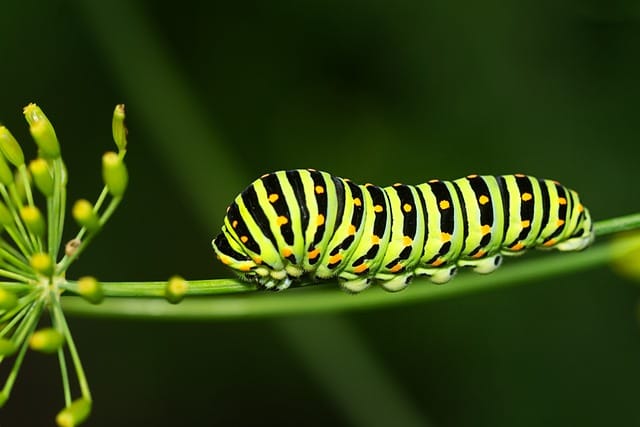Fighting gardening pests: Caterpillars
Caterpillars are common pests in gardens that can cause significant damage to plants if left uncontrolled

In this article:
- Introduction to Caterpillar Pests
- Identification of Common Caterpillar Pests
- Understanding the Life Cycle of Caterpillars
- Signs and Damage Caused by Caterpillars
- Natural and Organic Pest Control Methods
- Biological Control: Beneficial Insects for Caterpillar Control
- Chemical Control: Pesticides for Caterpillar Infestations
- Prevention Techniques for Caterpillar Pests
- Integrated Pest Management Strategies for Caterpillars
- Case Studies: Successful Caterpillar Pest Management
- Frequently Asked Questions about Caterpillar Pest Control
- Conclusion: Maintaining a Healthy Garden by Combating Caterpillar Pests
Introduction to Caterpillar Pests
Caterpillars are common pests in gardens that can cause significant damage to plants if left uncontrolled. Understanding their lifecycle, identification, and effective pest control methods is crucial for maintaining a healthy garden.
Identification of Common Caterpillar Pests
Identifying the specific caterpillar species infesting your garden is essential for implementing appropriate control methods. This section will provide an overview of the most common caterpillar pests and their distinguishing features.
Understanding the Life Cycle of Caterpillars
It is important to understand the life cycle of caterpillars in order to effectively target them at vulnerable stages. This section will explain the various stages of a caterpillar's life cycle and when intervention is most effective.
Signs and Damage Caused by Caterpillars
Recognizing the signs and symptoms of caterpillar infestation is crucial for prompt action. This section will describe the common signs and types of damage caused by caterpillars in gardens.
Natural and Organic Pest Control Methods
Natural and organic pest control methods are safe and environmentally friendly alternatives to chemical pesticides. This section will explore various natural methods, such as handpicking, companion planting, and the use of organic repellents.
Biological Control: Beneficial Insects for Caterpillar Control
Introducing beneficial insects that prey on caterpillars can be an effective, eco-friendly solution for controlling caterpillar populations. This section will discuss the role of beneficial insects and how to attract them to your garden.
Chemical Control: Pesticides for Caterpillar Infestations
While chemical pesticides should be used as a last resort, they can be effective in severe infestations. This section will provide guidelines on selecting and using pesticides specifically designed for caterpillar control.
Prevention Techniques for Caterpillar Pests
Prevention is key when it comes to managing caterpillar pests. This section will outline preventive techniques, such as maintaining a healthy garden, practicing proper sanitation, and using physical barriers to prevent caterpillar infestations.
Integrated Pest Management Strategies for Caterpillars
Integrated Pest Management (IPM) is a holistic approach that combines various pest control methods to effectively manage caterpillar populations. This section will provide a step-by-step guide to implementing an IPM strategy in your garden.
Case Studies: Successful Caterpillar Pest Management
Real-life case studies of successful caterpillar pest management can provide valuable insights and inspiration. This section will showcase specific examples of gardeners who successfully controlled caterpillar infestations using different methods.
Frequently Asked Questions about Caterpillar Pest Control
Answers to common questions about caterpillar pest control will be provided in this section to address any concerns or uncertainties gardeners may have.
Conclusion: Maintaining a Healthy Garden by Combating Caterpillar Pests
This concluding section will emphasize the importance of actively fighting caterpillar pests in order to maintain a thriving and productive garden.
